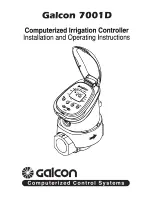
A GUIDED TOUR OF THE OVERDRIVE
The Outside
¬
Inputs:
The OVERDRIVE’s balanced inputs get their signals
directly from the main source unit/head unit. You’ll get noise rejection and
fewer ground loops from these guys. Don’t worry if your source is not
balanced. The OVERDRIVE will still reject the noise. We designed it that way.
Input Gain Control:
Used to increase the amount of signal to your
downstream signal processors or amplifiers. With this control you can get up
to 24dB of gain or 13 volts peak (9 volts RMS) to your signal processors or
amplifiers inputs. If your head unit’s maximum output is only 500mV, the
OVERDRIVE will be able to squirt out 8 volts RMS into the rest of your
system. Even if your head unit’s output is as little as 250mV, you can still get
4 volts RMS out of the OVERDRIVE Line Driver. However, be careful about
overdriving your average crossover or amplifier. Many can’t handle more than
about 2 volts input without clipping (AudioControl units can take much more).
If in doubt, check with the manufacturer.
®
Outputs:
Next to the inputs are the balanced outputs which should
be connected to the next component in your system. This could be an
equalizer, crossover, amplifier, or virtually any other electronic gadget you
may have in your system. If you connect the outputs to any AudioControl
component , you can rest assured it can handle the hot signal voltage from
the OVERDRIVE, up to 7.5 volts RMS.
Output status LEDs
¯
Power:
If you see this one lighted, pat yourself on the back for
properly connecting the power terminal.
°
Maximized:
When this light flickers while music is playing, you’re
pushing the limit — nearing the redline — entering the danger zone. Try
backing off on the Gain Control until it stops flickering.
2, 5, 7.5 Volt
: These lights will tell you when the signal level is at 2 volts,
5 volts or 7.5 volts RMS. You’ll most likely want at least the 2 volt light to
OVERDRIVE like The Epicenter or ESP-2, it is important that you change
these two jumpers to their Unbalanced position. The OVERDRIVE will
thank you.
´
Ground Isolation Jumpers
Should alternator whine rear its ugly head during the installation, we have
provided some alternate power supply grounding choices. Experiment with
different settings if you run into this problem. To change the settings, turn
system power OFF, move the black jumpers from the center two pins (fully
isolated) to either the top two pins (ground) or the bottom two pins (200
Ω
).
Short course in Signal-to-Noise
Ratio and Level Matching
Signal-to-noise ratio
is simply the difference between the signal level
and the noise floor of an electronic component. The higher the signal, the
better. Since you really can’t reduce the noise floor, signal-to-noise ratio can
be readily improved by raising the signal level. It’s best to get the signal
level up at the beginning of the signal path. The signal-to-noise ratio will
only be as good as the noisiest component. Which is why it’s important to
have a quiet head unit. This “weakest link” theory is the basic idea behind
setting levels in your car’s system. And that’s why AudioControl provides
gain in all of its signal processors.
Level Matching
is about making sure you run just the right amount of
signal into an electronic component. If you send too much, you’ll experience
the not so joyous sound of clipping. At the same time, you want the highest
possible signal levels for best signal-to-noise ratio. Since all AudioControl
products are capable of high-voltage input and output, it is important that
you MATCH the input voltage of your components. Most crossovers and
amplifiers can handle up to about 2 volts before they clip. AudioControl
signal processors can all put out at least 7.5 volts RMS, and can take in
anywhere from 5 to 9 volts RMS. LED voltage indicators on many of our
products make it a snap to set levels! Request Tech Note 1006 for more
information on level matching.
flicker, more if the rest of your components can handle it. Any AudioControl
component that you connect after the OVERDRIVE Line Driver won’t mind the
7.5 volt RMS light flickering. Go ahead. Light it up!
±
Power Connector
: This convenient little connector allows you to hook
up all the power and turn-on wires for your OVERDRIVE Line Driver in the
convenience of a well-lighted area and then plug them in by feel all at once in
your trunk’s cavernous darkness. Screws on top of the connector should face
up. But if you put the plug in upside down, nothing will be damaged, the
Overdrive just will not power up!
¬
®
°
±
The Inside
²
Input Grounding Jumpers
Leave this one set to BALANCED for most applications. Occasionally a
head unit may require that its output RCA shield be connected to ground. In
that event, go ahead and change the jumper position to UNbalanced.
³
Output Grounding Jumpers
We ship the OVERDRIVE with these in the BALANCED position. We
know you prefer balanced-input AudioControl components downstream, so we
set this one for you. If, however, you have an unbalanced input after the
²
³
´
- 4 -
- 5 -
- 6 -
- 7 -
























